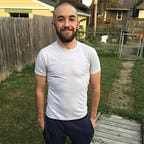HEIDI RESZIES ON THE MAKING OF ‘ILLUSORY BORDERS’ :: FIELD NOTES :: PART THREE :: MOON & MOON
In this third installment of our latest Field Notes entry, featuring the work and process of transdisciplinary artist and poet Heidi Reszies, we’re afforded a glimpse inside the rooms in which — and on which — her book Illusory Borders was written, and where the mixed-media installation that documents/embodies its writing, Blue-ing, came to be. Read on to learn more about the texts, voices, disciplines, materials, and practices that came together to produce these intricate (and interconnected) works. Then head over to The OS to pre-order Illusory Borders, and help get this work out into the world. [2018 series editor: Adrian Silbernagel]
I’d been in the habit of tacking poems-in-process to the wall of my writing space, a small nook in the corner of my bedroom, next to a south-facing window. Writing the poems that make up Illusory Borders, I was influenced by poets I was reading — Susan Howe, Mei-mei Berssenbrugge, C.D. Wright — poets whose writing employs collage, whether seen or unseen, as an element in the poetic process. I recall it was Wright’s Deepstep Come Shining that inspired me to combine my text on the wall (in this case, text defined as written or printed work) with images — primarily my growing collection of cyanotype prints.
Wright’s collection incorporates fragments of images, voices, memories, and folklore to create a lyrical collage or quilt, a text both dreamlike and cohesive. I say collage/ quilt because as I was reading this book I found myself wanting to see the poetry mapped out on the wall, to get a visual sense of exactly how the threads and lines interacted. What held it all together?
I wasn’t surprised to find, in my research, that Wright saw this poem on the wall, too. In an interview with Paul Magee in The American Poetry Review, Wright explains that her book was written during a month-long residency at the Virginia Center for Creative Arts (an art colony near Lexington, VA). “I had a white wall on which to mount my poem. I stared at it every day, like the painters in the Center were doing. I worked on it in an expressly visual way.”
Wright describes hanging the text on the wall in columns, making the columns talk to each other. In Deepstep, the voices and images in conversation are pieced together to create a multi-layered fabric. In an interview published in Pen America, Daniel Schoonebeck writes: “The result, to use one of C.D. Wright’s own words, is a welter of voices and images that weave a crosshatch throughout her entire body of work.”
Over the course of a year and a half, I’d assembled my manuscript alongside hundreds of cyanotype prints — these included a series of ‘moons’ that together resembled a sort of lunar calendar. These cyanotypes were photograms of layers of tissue paper in a glass petri dish. On a few sunny winter days, I experimented using snow instead of tissue.
I stitched my accumulation of moons (literally, with a sewing machine) together with tanka poems (from a tanka diary I’d been keeping for several months) to create a patchwork of blue…
…and all of this eventually became a mixed media installation titled Blue-ing. Click here to watch a short video clip of the installation in process at the Vermont College of Fine Arts in June 2015.
To some extent I think Blue-ing, as a text, exists separately from the series of poems that became Illusory Borders. But then I consider how Blue-ing documents/embodies my working through the process of writing…and the two become inseparable.
Heidi Reszies is a poet and transdisciplinary artist. She is the author of three chapbooks; her poetry and poetics have appeared in journals including The Volta, La Vague Journal, Forklift Ohio, Gramma, BOAAT, LEVELER, Salt Hill, SUSAN/the Journal, and Queen of Cups. She is the founding creator/curator of Artifact Press, and currently resides in Richmond, Virginia. Find her at heidireszies.com
